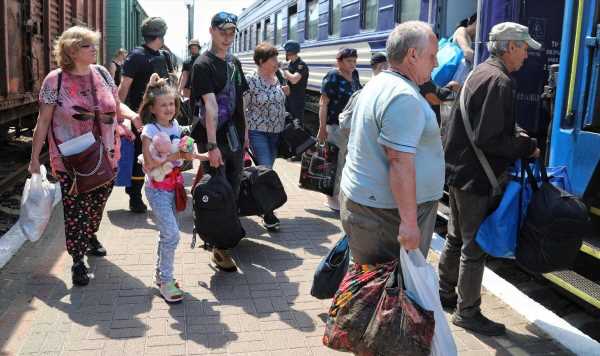
Following the incident, President Zelensky said he had convened an urgent meeting of the National Security Council and alleged that Russian forces set off a blast inside the dam structure that put 80 towns in danger.
The World Data Centre for Geoinformatics and Sustainable Development, a Ukrainian non-governmental organisation, warned the number could be even higher, and up to 100 towns could be flooded.
Furthermore, there are concerns about the impact of the dam burst on the Zaporizhzhia nuclear power plant which relies heavily on water to control its reactors.
In a statement, Ukraine’s nuclear operator, Energoatom said: “Water from the Kakhovsky Reservoir is necessary for the station to receive power for turbine capacitors and safety systems of the ZNPP. The station’s cooling pond is now full: as of 8:00 am, the water level is 16.6 meters, which is sufficient for the station’s needs.”
While Energoatom said blowing up the dam “could have negative consequences for the Zaporizhzhia nuclear power plant”, they said the situation was currently “controllable” for now.
On Twitter, the UN’s International Atomic Energy Agency (IAEA) said its experts were closely monitoring the situation at the power station and there was “no immediate nuclear safety risk”.
Alongside risks to one of Europe’s biggest nuclear power plants and the potential loss of up to 100 villages, there are fears that the blast will drain supplies of drinking water to Crimea, which Russia illegally annexed in 2014.
A senior adviser to President Zelensky, Mykhailo Podolyak said a “global ecological disaster is playing out now, online, and thousands of animals and ecosystems will be destroyed in the next few hours”.

We use your sign-up to provide content in ways you’ve consented to and to improve our understanding of you. This may include adverts from us and 3rd parties based on our understanding. You can unsubscribe at any time. More info
Ukraine’s foreign minister, Dmytro Kueba, said on Twitter: “Russia destroyed the Kakhovka dam inflicting probably Europe’s largest technological disaster in decades and putting thousands of civilians at risk.
He tweeted: “This is a heinous war crime. The only way to stop Russia, the greatest terrorist of the 21st century, is to kick it out of Ukraine.”
Following the attack, Foreign Secretary James Cleverley renewed the UK’s support for Ukraine, vowing to support them as they repel Russian forces.
Mr Cleverly said: “Intentionally attacking exclusively civilian infrastructure is a war crime. The UK stands ready to support Ukraine and those affected by this catastrophe.”
Don’t miss…
UK ‘vows to respond’ after Russia blows up Ukraine power station dam[UKRAINE]
Huge wave of water washes power station away after Russia blows up dam[UKRAINE]
Russian forces on brink of collapse as soldiers face ‘Ukraine syndrome’ – expert[UKRAINE]
He added: “I’ve heard reports of the explosion on the dam and the risk of flooding. It’s too early to make any kind of meaningful assessment of the details.
“But it’s worth remembering that the only reason this is an issue at all is because of Russia’s unprovoked full-scale invasion of Ukraine.”
Although the flooding caused by the blast will affect both Russian and Ukrainian forces, it is believed it could affect Russia’s army more.
Former minister for Kyiv’s central government, Tymofiy Mylovanov, said the Russian-occupied bank of the Dnieper River would likely suffer more than the Ukrainian-held side.
Source: Read Full Article
-
Venus Williams out of US Open in 1st round for 2nd time – The Denver Post
-
Family’s ‘well-trained’ pit bull ‘locked jaws’ around toddler’s head in mauling
-
Meghan called therapist at her ‘worst point’ – and she answered ‘who is this’
-
At least 52 dead after suicide bomb blast rocks mosque as second explosion kills two during Friday prayers in Pakistan | The Sun
-
Elon Musk spotted ‘recruiting volunteers for flight to Mars’ at World Cup Final

